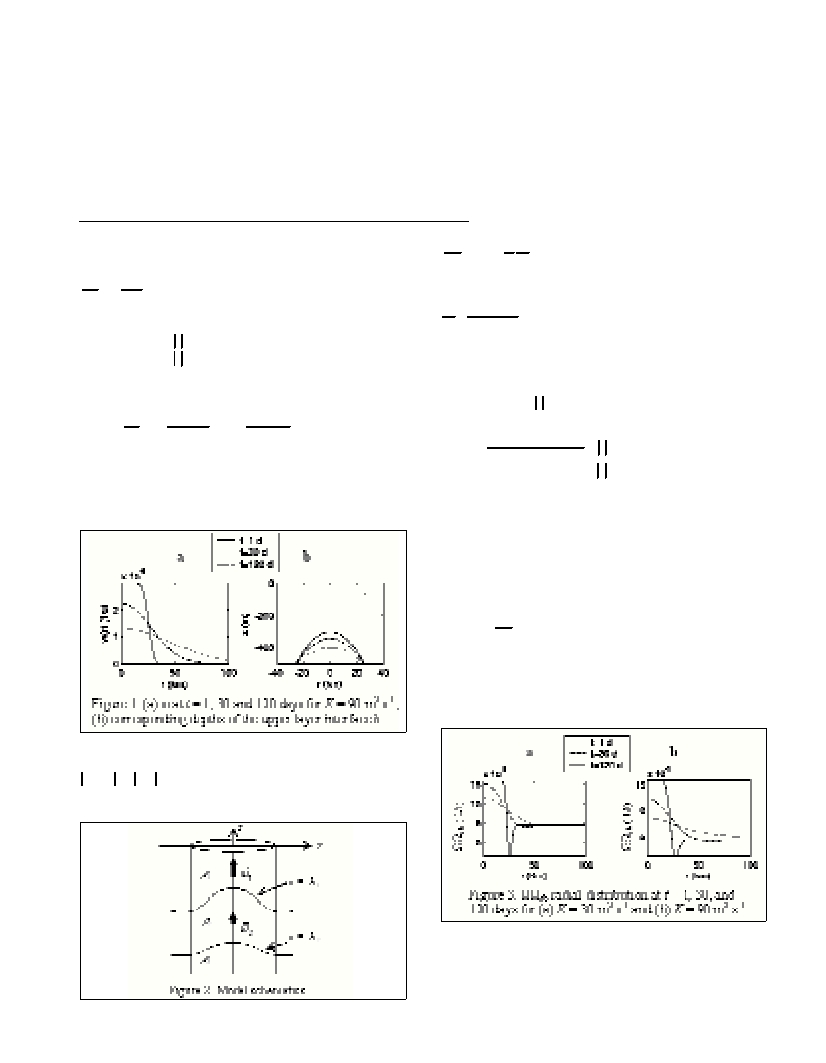Rapp. Comm. int. Mer Médit., 37,2004
134
A SIMPLE BAROCLINIC MODEL FOR DIFFUSIVE VORTICES
J. L. Pelegrí
1 *
, M. Auladell
1, 2
, E. García-Ladona
1
, J. Font
1
, and P. Sangrà
2
1
Institut de Cienciès del Mar, CMIMA-CSIC, Barcelona, Spain
2
Facultad de Ciencias del Mar, ULPGC, Gran Canaria, Spain
Abstract
A simple layered diffusive model describes the temporal evolution of the angular velocity and vertical structure of oceanic vortices. An
initial state specifies the core angular velocity of each layer and the density changes between adjacent layers. The temporal evolution of
the angular velocity for each layer is explicitly obtained solving the radial diffusive equation, with the diffusion coefficient determined
from a stability analysis, and the shape of the interfaces follows from the assumption of gradient ?ow.
Keywords: oceanic vortices, radial diffusion, inertial stability, layered model.
Transient mesoscalar vortices are a common feature in the
Mediterranean. A simple model for vortex evolution consists on radial
diffusion of angular velocity
?
(r,t),
,
(1)
where K(t)is a horizontal diffusion coefficient, for an initially rotating
cylinder
,
(2)
where aand
?
0
are the vortex’s initial radius and angular velocity
(positive/negative for cyclonic/anticyclonic). The solution, for
constant K, is [1]:
(3)
Figure 1a displays this solution at several times for an initial
cyclonic vortex with a= 25 km, |
?
0
| = 3
×
10
-5
s
-1
(period 2.5 days),
and K= 90 m
2
s
-1
. The size of the vortex slowly increases with time
while a central core remains in near solid body rotation. This core
remains discernable in time, although after some 30 days its rotation
rate decreases.
The above model may be generalized to a layered ocean (Fig. 2),
with a time-dependent K(t) for each layer, provided that
. The pressure pis hydrostatic and the interfaces’
shape may be determined under the assumptions that (a) the deep ?ow
is motionless and (b) the ?ow in each layer is in gradient balance:
K
t
K
?
<<
?
?
/
?
?
?
?
?
?
?
?
?
?
?
?-
-
?
?
?
?
?
?+
=
2
/
1
2
/
1
0
)
4
(
)
4
(
2
)
,
(
t
K
a
r
erf
t
K
a
r
erf
t
r
?
?
?
?
?
>
=
=
=
a
r
a
r
t
r
,
0
,
)
0
,
(
0
?
?
2
2
r
K
t
?
?
=
?
??
?
,
(4)
where fis the planetary vorticity. For a 1.5 layer model this equation
gives the slope of the active only interface,
,
(5)
where
and
?
1
,
?
2
are the upper and lower
layer densities. The actual interface depth is obtained through
integration from a distant unperturbed radial coordinate, .
A first approximation has the vortex in solid body rotation
for , the interface h(r,t) becoming a function of
?
c
:
(6)
Figure 1b illustrates the interface evolution for a cyclonic vortex at
52ºN, the sloping interface resembling observations of tilted
isopycnals in vortices.
The model requires a knowledge of K(t) for all layers. Within each
layer the angular velocity is approximately constant at the vortex core
so any diffusion there simply redistributes particles with similar
angular velocities. Hence, for each layer the effective diffusion
coefficient depends on the stability at the vortex edge, which we
assess using the theory of radial stability in barotropic structures [2].
At lowest order the radial velocity is unstable when
, where
and
.
Figures 3a,b show the radial distribution of
??
sb
for a cyclonic
vortex, at different times, using two different diffusion coefficients.
For cyclonic vortices edge stability leads to estimates of K(t): a
negative minimum at the vortex edge is interpreted as a too small
coefficient (Figures 3a,b). For anticyclonic vortices the eddy’s edge is
rather stable leading to a small effective diffusion [1].
References
[1] Sangrà P., Pelegrí J.L., Arregui I., Martín J.M., Hernández-Guerra A.,
Marrero-Díaz A., Martínez A., and Rodríguez-Santana A., 2004. Life story
of an anticyclonic eddy. J. Geophys. Res., submitted.
[2] Hopfinger E.J., and Van Heijst G.J.F., 1993. Vortices in rotating ?uids.
Ann. Rev. Fluid Mech., 25: 241-289.
?
2
+
=
?
f
sb
r
r
f
?
?
+
+?
?
2
0
<
?
?
sb
?
?
?
?
?
>
=
-
+
+
=
a
r
H
a
r
g
a
r
f
H
h
c
c
,
,
'
2
)
)(
(
2
2
?
?
a
r
=
c
t
r
?
?=
=
)
,
0
(
H
z
-
=
1
1
1
2
/
/
)
(
'
?
d?
?
?
?
=
-
=
g
g
'
)
(
g
r
f
r
h
+
=
?
??
?
r
p
v
f
r
v
?
?
=
+?
?
?
1
2

